(完整word版)一般现在时态
(完整word版)八种时态主动语态被动语态
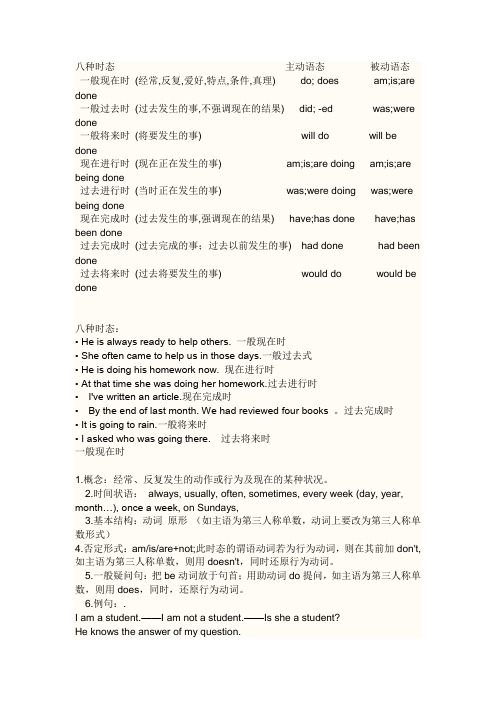
八种时态主动语态被动语态一般现在时(经常,反复,爱好,特点,条件,真理) do; does am;is;are done一般过去时(过去发生的事,不强调现在的结果) did; -ed was;were done一般将来时(将要发生的事) will do will be done现在进行时(现在正在发生的事) am;is;are doing am;is;are being done过去进行时(当时正在发生的事) was;were doing was;were being done现在完成时(过去发生的事,强调现在的结果) have;has done have;has been done过去完成时(过去完成的事;过去以前发生的事) had done had been done过去将来时(过去将要发生的事) would do would be done八种时态:• He is always ready to help others. 一般现在时• She often came to help us in those days.一般过去式• He is doing his homework now. 现在进行时• At that time she was doing her homework.过去进行时• I've written an article.现在完成时• By the end of last month. We had reviewed four books 。
过去完成时• It is going to rain.一般将来时• I asked who was going there. 过去将来时一般现在时1.概念:经常、反复发生的动作或行为及现在的某种状况。
2.时间状语:always, usually, often, sometimes, every week (day, year, month…), once a week, on Sundays,3.基本结构:动词原形(如主语为第三人称单数,动词上要改为第三人称单数形式)4.否定形式:am/is/are+not;此时态的谓语动词若为行为动词,则在其前加don't,如主语为第三人称单数,则用doesn't,同时还原行为动词。
英语中的十六种时态(可编辑修改word版)

英语中的十六种时态(1)一般现在时基本形式(以do为例):第三人称单数:does(主语为非第三人称单数);肯定句:主语+动词原形+其他;He works for us.否定句:主语+don't/doesn't+动词原形+其他;He doesn't work for us.一般疑问句:Do/Does+主语+动词原形+其他。
肯定回答:Yes,(+主语+do/does).否定回答:No,(+主语+don't/doesn't.)特殊疑问句:疑问词+一般疑问句语Does he work for us?Yes, he does.No, he doesn'tWhat does he do for us?He works for us.(2)一般过去时be动词+行为动词的过去式否定句式:在行为动词前加didn't,同时还原行为动词,或was/were+not;was或were放于句首;用助动词do的过去式did提问,同时还原行为动词例如: Did he work for us?He didn't work for us.He worked for us.(3)一般将来时am/are/is+going to+do 或will/shall+doam/is/are/about to + doam/is/are to + do;一般将来时的表达方法be going to +动词原形be +不定式,be to+动词原形,be about to +动词原形be able to +不定式be about to+动词原形will + 动词原形;例如:He is going to work for us.He will work for us;He is coming.这是特殊的用一般现在时表达将来时态的例子!!(4)过去将来时be(was,were)going to+动词原形be(was,were)about to+动词原形be(was,were)to+动词原形肯定句:主语+be(was,were)going to+动词原形~.否定句:主语+be(was,were)not going to+动词原形~.疑问句:Be(Was,Were)+主语+going to+动词原形~?肯定句:主语+would(should)+动词原形~.否定句:主语+would(should)not+动词原形~.疑问句:Would(Should)+主语+动词原形~?He would work for us.(5)现在进行时主语+be+v.ing〔现在分词〕形式(其中v表示动词)表示现在正在进行的动作或最近在做的事。
(完整word版)英语十六大时态用法大集合
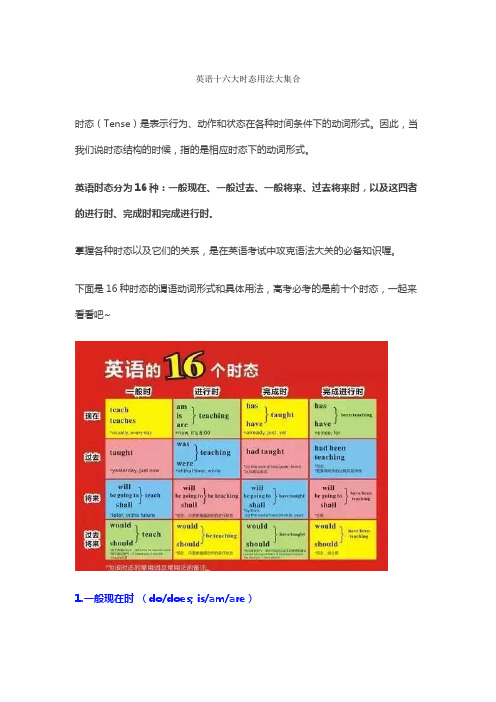
英语十六大时态用法大集合时态(Tense)是表示行为、动作和状态在各种时间条件下的动词形式。
因此,当我们说时态结构的时候,指的是相应时态下的动词形式。
英语时态分为16种:一般现在、一般过去、一般将来、过去将来时,以及这四者的进行时、完成时和完成进行时。
掌握各种时态以及它们的关系,是在英语考试中攻克语法大关的必备知识喔。
下面是16种时态的谓语动词形式和具体用法,高考必考的是前十个时态,一起来看看吧~1.一般现在时(do/does; is/am/are)①表示现在的情况、状态或特征。
例:He is a student.他是一个学生。
②表示经常性、习惯性动作。
例:He always helps others.他总是帮助别人。
③客观事实和普遍真理。
例:The earth moves the sun.地球绕着太阳转。
④表示一个按规定、计划或安排要发生的动作。
仅限于某些表示“来、去、动、停、开始、结束、继续”等的动词,可以与表示未来时间的状语搭配使用。
常见的用法是:飞机、火车、轮船、汽车等定期定点运行的交通方式。
例:The next train leaves at 3 o'clock this afternoon.下一趟火车今天下午3点开车。
⑤在时间、条件和让步状语从句中经常用一般现在(有时也用现在完成时)表示将的来事情。
(即:主将从现原则)例:I will call you as soon as I arrive at the airport.我一到机场就会给你打电话。
When you have finished the report, I will have waited for about 3 hours. 等你完成这份报告的时候,我就已经等了将近3个小时了。
2. 现在进行时(am/is/are doing)①表示此时此刻正在发生的事情。
例:He is listning to the music now.他现在正在听音乐。
一般现在时(word)

般现在时( word)一、一般现在时1.My brother is ________ his homework. He often __________ his homework at home.A. does; doingB. doing; doC. do; doingD. doing; does【答案】D【解析】【分析】第一个空前面有动词is,填doing 构成现在进行时,第二个空often 是一般现在时的标志,主语he 是第三人称单数,动词用三单形式does,故选D。
句意是:我弟弟正在做家庭作业。
他经常在家里做家庭作业。
点评】本题考查现在进行时和一般现在时的用法。
2.My father is a tea lover. He ____________ tea every day.A. drink B . drinks C . drank D . will drink【答案】B【解析】【分析】句意:我爸爸是一个茶痴,他每天都喝茶。
every day 表明时态是一般现在时,主语是he,所以drink 用drinks ,C 是一般过去时;D 是一般将来时,故选B。
【点评】考查一般现在时,注意平时识记其标志词及动词的单三式。
3.She always keeps a balanced diet. It _______ different kinds of foods.A. includeB. includesC. includingD. included【答案】B【解析】【分析】句意:她总是保持均衡饮食。
均衡饮食包括不同种类的食物。
include 在句中作谓语,故排除非谓语形式including ,根据She always keeps a balanced diet. 可知句子时态为一般现在时,主语It 是第三人称单数,谓语动词使用单三形式,故答案是B。
【点评】考查一般现在时,注意一般现在时单三形式在具体语境中的运用。
(完整word版)初中英语动词在各种时态中的变化规则
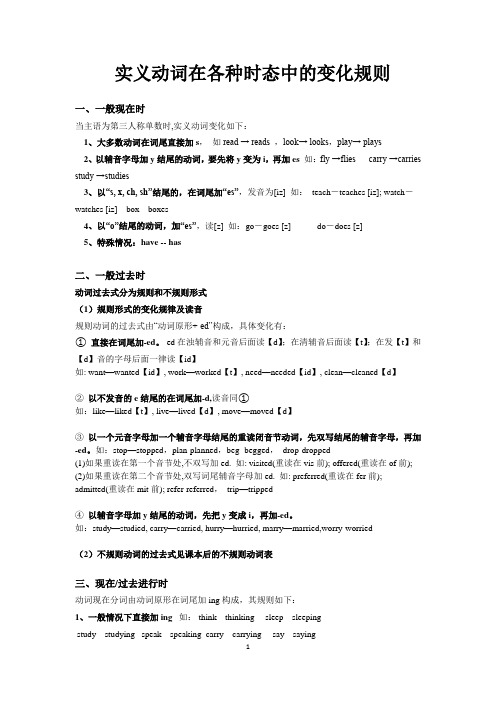
实义动词在各种时态中的变化规则一、一般现在时当主语为第三人称单数时,实义动词变化如下:1、大多数动词在词尾直接加s,如read → reads ,look→ looks,play→ plays2、以辅音字母加y结尾的动词,要先将y变为i,再加es如:fly →flies carry →carries study →studies3、以“s, x, ch, sh”结尾的,在词尾加“es”,发音为[iz] 如:teach-teaches [iz]; watch-watches [iz] box---boxes4、以“o”结尾的动词,加“es”,读[z] 如:go-goes [z] do-does [z]5、特殊情况:have -- has二、一般过去时动词过去式分为规则和不规则形式(1)规则形式的变化规律及读音规则动词的过去式由“动词原形+-ed”构成,具体变化有:①直接在词尾加-ed。
-ed在浊辅音和元音后面读【d】;在清辅音后面读【t】;在发【t】和【d】音的字母后面一律读【id】如: want—wanted【id】, work—worked【t】, need—needed【id】, clean—cleaned【d】②以不发音的e结尾的在词尾加-d,读音同①如:like—liked【t】, live—lived【d】, move—moved【d】③以一个元音字母加一个辅音字母结尾的重读闭音节动词,先双写结尾的辅音字母,再加-ed。
如:stop—stopped,plan-planned,beg- begged,drop-dropped(1)如果重读在第一个音节处,不双写加ed. 如: visited(重读在vis前); offered(重读在of前);(2)如果重读在第二个音节处,双写词尾辅音字母加ed. 如: preferred(重读在fer前); admitted(重读在mit前); refer-referred,trip—tripped④以辅音字母加y结尾的动词,先把y变成i,再加-ed。
(完整word版)八大时态标志词

(完满word版)八大时态标志词一般现在时标志词:every day,evry Sunday,often,always,usually,sometimes ,on Sundays, on weekdays等等。
一般过去时标志词:ago, yesterday,the day before yesterday,last week/year/night/month...,in 1989, just now,at the age of ,one day ,ago, long ago,once upon a time,(从前,许久从前)then( 那时 ), on that day (在那天) ,一般将来时标志词:soon, tomorrow, the day after tomorrow (后天),this evening/afternoon/yearbefore long( 不久今后),next year/month/week/summer , in the future,some day(将来的某一天 ) ,in two weeks/days/years现在进行时标志词:now. Look . Listen. these days,at that time.at that moment.this time,yesterday evening过去进行时标志词:at that time. at that moment. this time yesterday evening 等;也许与when, while, as 引导的过去时间状语连用。
现在完成时标志词:already(用于必定句), yet (用于否定,疑句), just, before, recently,still, lately,never, ever, never, twice, on several occasion, in the past few days/weeks/months/years, (up to)these fewdays/weeks/months/years, this morning/week/month/year, just,up to present, so far, up to now, till now, since+过去完成志:by, by the time (of), by the end of +去;when. before.after ⋯⋯ .+ 去;up till then ( 直到 ); up until last night( 直到昨晚)等;already, just, ever, yet等。
(完整word版)一般现在时态
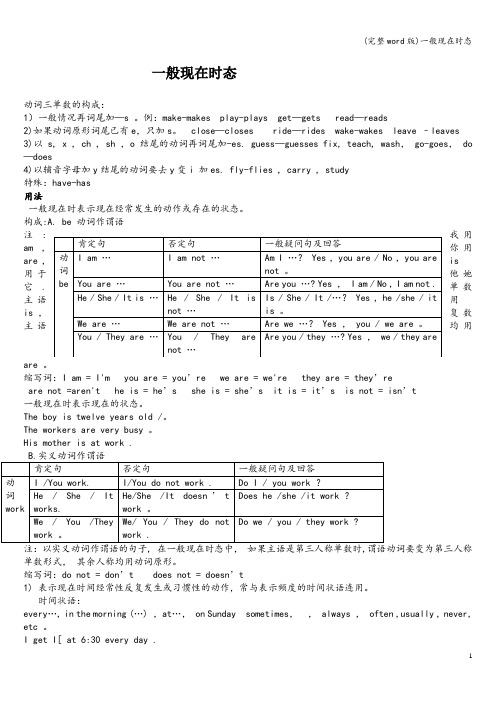
一般现在时态动词三单数的构成:1)一般情况再词尾加—s 。
例:make-makes play-plays get—gets read—reads2)如果动词原形词尾已有e,只加s。
close—closes ride—rides wake-wakes leave –leaves3)以s, x , ch , sh ,o 结尾的动词再词尾加-es. guess—guesses fix, teach, wash, go-goes, do —does4)以辅音字母加y结尾的动词要去y变i 加es. fly-flies , carry , study特殊:have-has用法一般现在时表示现在经常发生的动作或存在的状态。
构成:A. be 动词作谓语注: 我用Array am , 你用are , is用于他她它.单数主语用is ,复数主语均用are 。
缩写词:I am = I'm you are = you’re we are = we're they are = they’reare not =aren't he is = he’s she is = she’s it is = it’s is not = isn’t一般现在时表示现在的状态。
The boy is twelve years old /。
The workers are very busy 。
His mother is at work .单数形式,其余人称均用动词原形。
缩写词:do not = don’t does not = doesn’t1) 表示现在时间经常性反复发生或习惯性的动作,常与表示频度的时间状语连用。
时间状语:every…, in the morning (…) ,at…, on Sunday sometimes,, always , often ,usually , never, etc 。
I get I[ at 6:30 every day .She always helps others .He often goes to school on foot.I usually leave home for school at 7 every morning。
(word完整版)朗文语法及句型汇总,文档.docx

单元5、语法及句型汇总Level Starter句型中心句型扩展句型重复句型级别句型总量1Fun inClass2 My Family 1、一般现在时态(指令):一般现在时态():isStand up! 等Eg: It ’s a blue crayon.2、一般现在时态( yes/no问句) :Eg: -Is it yellow?–Yes, it is. /No, it isn ’t.3、单、复数名词:Eg: One pencil. Two pencils.1、一般现在时态( be, see的用法): 1、非正式打招呼用语:Eg: The mother is in the living Hello. Good-bye.room. We are having fun.2、由 who do you see?引申出来的:I see the father.-What do you see?2、介词 (in):- I see a backpack.Eg: My sister is in the bedroom.3、 yes/no 问句:3、where, who 问句:Eg: -Is the mother in the kitchen?Eg: Where is the mother?-Yes, she is. /No, she isn’t.Who do you see?1、一般现在时态( is):Eg: The mother is in the living room.2、yes/no问句:Eg: -Is the mother in the kitchen?-Yes, she is. /No, she isn’t.中心句型量30扩展句型量283 All About 1、现在时态(指令):1、一般现在时态 (be):1、现在时态(指令):Point to your ears.等There are three circles.Point to your ears.等重复句朗文 BACKPACK 少儿英语Me2、单、复数名词:I’m happy.Eg: Two ears. One nose.It’s a triangle.3、代词( my, your ) :2、 where 问句:Eg: My eyes.Where are the books?Shake your leg.3、代词( I, you ):4、形容词( happy, sad) :Eg: I see hands. I see you.’’4、谈论颜色:I m happy.I m sad.Eg: -What color is your nose?–It’s red.1、现在进行时态( wearing):1、 what 问句:Eg: He is wearing shorts.Eg: What ’s she wearing?2、一般现在时态:2、 where 问句 :Eg: There are three hats. It’s hot.Eg: Where are my shoes?3、单、复数名词:3、所有格(’s):4Eg: This is Kate ’s jacket.Eg: Three hats. A rectangle.My4、介词( in ):Clothes Eg: I have a bathroom in mybackpack.1、一般现在时态( what问句):1、一般现在时态( be ) :Eg: -What do you see?Eg: There are six teddy bears.-I see a ball.2、一般现在时态( want ):2、一般现在时态(有礼貌的请求):Eg: I want a truck, please.53、代词( I, me, you, my) :Eg: -I want a truck, please.At the Toy-Here.Eg: I see a truck.Store-Thank you.Show me a truck.-You ’re welcome.Thank you.3、单、复数名词:This is my doll.Eg: One doll. Five cars.教学资源手册2、单、复数名词:型量Eg: Two ears. One nose.3、一般现在时态 (be):31 There are three circles.It ’s a triangle.4、where问句:Where are the books?1、一般现在时态 :Eg: There are three hats.It ’s hot.2、单、复数名词:Eg: Three hats. A rectangle.3、what问句:Eg: What ’s she wearing?4、where问句:Eg: Where are my shoes?5、介词( in ):Eg: I have a bathroom in my backpack.1、一般现在时态( what问句, be):Eg: -What do you see?-I see a ball.There are six teddy bears.2、单、复数名词:Eg: One doll. Five cars.3、代词( I, you, my ):Eg: I see a truck.Thank you.This is my doll.1、一般现在时态( who 问句):1、一般现在时态( be ) :1、一般现在时态( who 问句 , be ):Eg: Who ’s she?Eg: I am a taxi driver.Eg: Who ’s she?62、主格代词( I, he, she ):She is a nurse.I am a taxi driver.People Eg: He ’s a doctor.There are five blue squares.She is a nurse.Around I ’m a taxi driver.2、代词( you ):There are five blue squares. Town’Eg: Do you see anyone you know?2、代词( I, you ):She s a bus driver.Eg: I m’ a taxi driver.Do you see anyone you know?1、主格代词( I, she, he, you):1、一般现在时态( be ):1、主格代词( I, she, he, you ) :Eg: I m’ jumping.Eg: There are seven triangles.Eg: I m’ jumping.She ’s running.2、 have:She ’s running.He ’s swinging.Eg: We have ten books.He ’s swinging.7You ’re sliding.3、 how many 问句:You ’re sliding.2、现在进行时态:Eg: -How many are running?2、现在进行时态:SwingingEg: I m’ jumping.- Nine children are running.Eg: I m’ jumping.and3、介词的用法:4、 yes/no 问句:3、一般现在时态 (be) :Slidingdown, in, on, out, up Eg: -Is he jumping rope?Eg: There are seven triangles.-Yes, he is. /No, he isn ’t.4、介词( in ):5、yes/no 问句:Eg: -Is he jumping rope?-Yes, he is. /No, he isn’t.1、现在进行时态:1、代词( we ) :1、现在进行时态:Eg: The giraffes are eating.Eg: We are at the zoo.Eg: The giraffes are eating.82、一般现在时态:2、单、复数名词谓语动词的变化:2、一般现在时态:Eg: It ’s a big elephant.Eg: What is the seal doing?Eg: It ’s a big elephant.AnimalThere are six dogs.What are the seals doing?There are six dogs.Friends3、描述性形容词:3、 yes/no 问句:3、yes/no 问句:Eg: It ’s big.Eg: -Is it a big table?Eg: -Is it a big table?-Yes, it is. /No, it isn ’t.-Yes, it is. /No, it isn ’t.91、一般现在时态( yes/no问句):1、复数名词:1、一般现在时态( yes/no问句):Food IEg: -Do you like apples?Eg: Two bananas.Eg: -Do you like apples?Like-Yes, I do. /No, I don ’t.2、一般现在时态( be ) :-Yes, I do. /No, I don’t.2、一般现在时态( like, want ):Eg: There are two pencils.2、一般现在时态( want) :Eg: I like bananas.There is one pencil.Eg: I want an apple.I want an apple.3、单数第三人称的一般疑问句:3、what 问句:3、what 问句:Eg: -Does she like oranges?Eg: Want do you want?Eg: Want do you want?-Yes, she does.4、复数名词:4、 have:Eg: Two bananas.Eg: -Do you have apples?5、一般现在时态( be ):-Yes, I do. I have one apple.Eg: There are two pencils.There is one pencil.6、have:Eg: -Do you have apples?-Yes, I do. I have one apple.单元1 Readyfor SchoolLevel 1句型中心句型扩展句型重复句型1、一般现在时态( be ):1、自我介绍:1、一般现在时态( be ):Eg: Kim is ready for school.-Hi. My name is Miss Jones. What ’s Eg: Kim is ready for school.2、what 问句:your name?2、what 问句:Eg: -What ’s this?-It ’s a backpack.-My name is Carlos.Eg: -What ’s this?-It ’s a backpack.3、代词( I, it, this ) :2、谈论颜色:3、代词( I) :Eg: I ’m ready for school.Eg: -What color is it?-It ’s green.Eg: I m’ ready for school.级别句型总量中心句型量38It is a pen.What ’s this?4、形容词性物主代词( my, your ):Eg: My name is Maria.What ’s your name?5、单、复数名词:Eg: One pen. Two tables.1、how many, who问句:1、代词( this, I, they, we, it): Eg: How many sisters do you Eg: This is my sister.have?I have one brother.Who is she?Here they come.2、一般现在时态( be, have):We need teams.Eg: She is my mother.What is it?Who am I?2、形容词性物主代词( your ): You are Pam.Eg: What ’s your name?2I have two brothers.3、 don ’t have:3、形容词性物主代词( my ):’People Eg: I don t have any crayons.Eg: He is my brother.He doesn ’thave any brother. We4、代词( he, she, you ) :4、 what 问句 :Love Eg: He is my father.Eg: What letter is it?She is my mother.You ’re Tim.4、形容词性物主代词( my, your ) :Eg: My name is Maria.扩展句型What ’s your name?5、单、复数名词:量Eg: One pen. Two tables.6、谈论颜色:34 Eg: -What color is it?-It ’s green.1、how many, who问句:Eg: How many sisters do youhave?Who is she?2、一般现在时态( be, have):Eg: She is my mother.Who am I?You are Pam.重复句型I have two brothers.3、形容词性物主代词( my, your) :量Eg: He is my brother.What ’s your name?58 4、代词(he, she, you,this, I, we, it ):Eg: He is my father.She is my mother.You ’re Tim.This is my sister.I have one brother.We need teams.What is it?5、what问句:1、一般现在时态( have ) :1、代词( me, you, he, it, she, I) : Eg: How many arms does she Eg: Look at me in the air.have?What do you see?2、yes/no, how many问句:He is big.Eg: -Does she have big eyes?It is long.-Yes, she does./No,she She is little.3doesn ’t.I have one head. How many arms does she have?2、比较和对比:Head to3、置于名词之前的形容词:Eg: She is little.She is big.ToesEg: A little nose.3、 has:Eg: She has two arms.4、形容词性物主代词( your ):Eg: Use your arms.5、一般现在时态( is):Eg: She is little.1、现在进行时态( wearing ) :1、一般现在时态 (be):Eg: I ’m wearing my pink dress.Eg: My jacket is blue.2、置于名词之前的形容词:What are your favorite clothes?Eg: A green skirt.2、代词( he, I, she, you, it, this, me,3、复数名词:they, ) :Eg: Four socks.Eg: He ’s wearing a red jacket.4、What 问句:I ’m wearing a white shirt.Eg: What is the clown wearing?She ’s wearing a dress.4What are you wearing?Things IIt is a black jacket.WearWhat ’s this?A boy is laughing at me.They are small.Eg: What letter is it?1、一般现在时态( have, be): Eg: How many arms does she have? She is little.2、yes/no, how many问句:Eg: -Does she have big eyes?-Yes, she does./No,shedoesn ’t.How many arms does she have?3、代词( you, he, it, she, I):Eg: What do you see?He is big.It is long.She is little.I have one head.4、形容词性物主代词( your ):Eg: Use your arms.1、现在进行时态( wearing ) :Eg: I ’m wearing my pink dress.2、置于名词之前的形容词:Eg: A green skirt.3、复数名词:Eg: There are four socks.4、What 问句:Eg: What is the clown wearing?5、一般现在时态 (be):Eg: My jacket is blue.What are your favorite clothes? 6、代词( he, I, she, you, it, this, me,朗文 BACKPACK 少儿英语教学资源手册3 、形容词性物主代词(her,his, my,they, ) :your)Eg: He ’s wearing a red jacket.Eg: My shirt is new.I ’m wearing a white shirt.Point to your shoes.She ’s wearing a dress.4、表达喜好 (like) :What are you wearing?Eg: I like shirts and pants.It is a black jacket.What ’s this?A boy is laughing at me.They are small.7、形容词性物主代词 (my, your)Eg: My shirt is new.Point to your shoes.1、一般现在时态:1、代词( we, I, you, he, she):1、一般现在时态 (be) :Eg: Where are you?Eg: We can do.Eg: Where are you?She is in the kitchen.I see four blue squares.She is watching TV.I see four blue squares.How many blue squares do2、现在进行时态:2、现在进行时态:you see?Eg: He ’s eating in the kitchen.’’3、what, where 问句:Eg: He s eating in the kitchen.He s in the kitchen.3、what, where 问句:She ’s eating.Eg: What is she doing?5Eg: What is she doing?2、 How many 问句 :Where ’s the mother?At Where ’s the mother?Eg: How many rooms do you see?4、代词( we, I, you, he, she ) :Home Eg: We can do.I see four blue squares.How many blue squares doyou see?He ’s in the kitchen.She ’s eating.5、How many 问句 :Eg: How many rooms do you see?61、一般现在时态和现在进行时态:1、比较和对比:1、一般现在时态和现在进行时态:朗文 BACKPACK少儿英语教学资源手册On the Eg: This is a frog.Eg: This is a frog. It’s a big frog.Farm The bird is flying.This is a frog too. It ’s a little frog.2、what 问句:2、代词( I, me ):Eg: What is it doing?Eg: I m’ chasing everybody out of3、代词( it, he, she, they, you) :my house.Eg: It ’s a bird.Me, too?He ’s running.3、复数名词的谓语动词:She’s walking.Eg: What are the horses doing?They are jumping.What are you doing?1、一般现在时态:1、代词( I, you ,he, she,it ) :Eg: Today is Friday.Eg: I m’ six years old.2、yes/no 问句:How old are you?-Do you like milk?He has milk.7–Yes, I do. /No, I don’t.She has fish.Celebra3、how old, when问句:’It s Monday.tions-How old are you?2、形容词性物主代词( my, your): -I ’m six years old.Eg: My birthday is on Friday thisWhen is your birthday?year.When is your birthday?3、表达喜好( like ):Eg: This is a frog.The bird is flying.2、what问句:Eg: What is it doing?3、代词( it, he, she, they, you, I, me ) :Eg: It ’s a bird.He ’s running.She ’s walking.They are jumping.What are you doing?I ’m chasing everybody outof my house.Me, too?4、比较和对比:Eg: This is a frog. It ’s a big frog. This is a frog too. It’s a little frog.5、复数名词的谓语动词:Eg: What are the horses doing? 1、一般现在时态:Eg: Today is Friday.2、yes/no问句:-Do you like milk?–Yes, I do. /No, I don’t.3、代词( I, you , he, she , it ): Eg: I m’ six years old.How old are you?He has milk.She has fish.It ’s Monday.朗文 BACKPACK少儿英语教学资源手册Eg: -Do you like milk?-Yes, I do.4、形容词性物主代词( my, your) :4、 what 问句:Eg: My birthday is on Friday thisEg: -What does he have?year.-He has milk.When is your birthday?5、 have/has:5、表达喜好( like ):Eg: -What does he have?Eg: -Do you like milk?-Yes, I do.-He has a sandwich.6、what 问句:Eg: -What does he have?-He has milk.7、have/has:Eg: -What does he have?-He has a sandwich.1、一般现在时态( be, have, want):1、 what 问句:1、一般现在时态( be, have):Eg: Where is the crayon?Eg: -What does he want?Eg: Where is the crayon?My toys are in my toy box.-He wants the balls.My toys are in my toy box.I have a toy box.2、 where 问句:I have a toy box.He wants the balls.Eg: -Where are the balls?2、介词( in ):Eg: It ’s in the box.2、表示位置的介词(in, on, under):-They are on the shelf.3、what 问句:Eg: It ’s in the box.3、 how many问句:Eg: -What does he want?It ’s on the book.Eg: How many blocks are there?-He wants the balls.It ’s under the box.4、 yes/no 问句:4、where问句:Eg: -Does the doll have brown hair?Eg: -Where are the balls?-Yes, it does. /No, it doesn ’t.-They are on the shelf.85、现在进行时态:5、how many问句:Eg: What is the doll wearing?Eg: How many blocks are there?Play6、 these/those:6、yes/no问句:TimeEg: Do you want these big skates?Eg: -Does the doll have brownDo you want those skates?hair?-Yes, it does. /No, it doesn’t.7、代词( I, you ):7、现在进行时态:Eg: I want a boat.Eg: What is the doll wearing?朗文 BACKPACK少儿英语What do you want?1、yes/no 问句:1、一般现在时态 (be) :Eg: -Is he singing?Eg: Those books are green.–Yes, he is/No, he isn ’t.This bicycle is red.2、现在进行时态:2、代词( he, she, they):Eg: Is he jumping rope?Eg: Is he singing?3 、指示代词( this, that, these,Is she dancing?9those ):They are dancing.At the Eg: This bicycle is red.Playgro-That bicycle is blue.-und These books are yellow.Those books are green.教学资源手册8、代词( I, you ) :Eg: I want a boat.What do you want?1、yes/no问句:Eg: -Is he singing?–Yes, he is/No, he isn’t.2、现在进行时态:Eg: Is he jumping rope?3、代词( this, these, those, he, she,they ):Eg: This bicycle is red.These books are yellow.Those books are green.Is he singing?Is she dancing?They are dancing.4、一般现在时态 (be) :Eg: Those books are green.This bicycle is red.Level 2句型级别句单元中心句型扩展句型重复句型型总量朗文 BACKPACK少儿英语1、缩写( she ’s, he ’s, they ’re ):Eg: She ’s gluing shapes.He ’s reading a book.They’re listening to a story.2、现在进行时态( v-ing ):Eg: She ’s erasing the board.3、what, how many问句:Eg: What is the boy doing?1How many crayons are there?First Dayof Class1、一般现在时态和现在进行时态:Eg: The dog is under the bush.They ’re playing hide and seek.2、单数人称和复数人称动词的变化:Eg: She likes to throw the ball.They like to ride bikes.3、Like to:Eg: They like to ride bikes.24、who, what, where问句:Fun andEg: Who likes to ride?GamesWhat do they like to do?教学资源手册1、一般现在时态( be ):1、现在进行时态:中心句Eg: I am David.Eg: She ’s erasing the board.My name is Miss Grant.2、what, how many问句:There are seven crayons.Eg: What is the boy doing?型量2、 have:How many crayons are there?45 Eg: I have a blue pencil.3、一般现在时态( be ):3、自我介绍和问候:Eg: I am David.扩展句-Good morning! My name is Miss My name is Miss Grant.Grant. What ’s your name?There are seven crayons.型量-Hello. I m’ David.4、have:4、代词( he, she, they ) :Eg: I have a blue pencil.18 Eg: He ’s counting markers.5、自我介绍:She’s erasing the board.-My name is Miss Grant.What ’sThey ’re listening to a story.your name?-Hello. I ’m David.6、代词( he, she, they):Eg: He ’s counting markers.She ’s erasing the board.They ’re listening to a story.1、一般现在时态和现在进行时态:重复句Eg: The dog is under the bush.They ’re playing hide and seek.型量2、who, what, where问句:Eg: Who likes to ride?46What do they like to do?Where ’s the ball?3、介词( in, under, on):Eg: The marbles are in the cup.The checkers are on thecheckerboard.Where ’s the ball?5、介词( behind, in, in front of, next to, under, between, on):Eg: The kite is behind the cat.The marbles are in the cup.The ball is in front of the kite.The cup is next to the checkerboard.The tennis racket is under the jump rope.The bat is between the tennis racket and the cup.The checkers are on the checkerboard.The tennis racket is under the jump rope.1、一般现在时态:1、 what 问句:1、一般现在时态:Eg: My mother has a father.Eg: What ’s in your bedroom?Eg: My mother has a father.2、缩写:2、 there is/there are:2、who, where问句:Eg: Where ’s the sofa?Eg: There is a bed in my bedroom.Eg: Who ’s that?3、who, where, is there/are there问There are four chairs and a dining Where is the lamp?3句:table in my dining room.3、what问句:Our Eg: Who ’s that?3、形容词性物主代词( my ):Eg: What’s in your bedroom?New Where is the lamp?Eg: My name is Lisa.4、there is/there are:House Is there a radio in your house?Eg: There is a bed in my bedroom.Are there two chairs in your room?There are four chairs and adining table in my diningroom.5、形容词性物主代词( my ):Eg: My name is Lisa.41、一般现在时态:there is/there isn’t/there are:1、一般现在时态:My Eg: There is a shoe store next to the Eg: There is a post office on Pine Eg: There is a shoe store next toTown supermarket.Street.2、表示位置的介词 (between, in, next There isn’t a fire station on Elmto, on the corner, on):Street.Eg: The movie theater is between There are stores in my the music store and the neighborhoodrestaurant.There are stores in myneighborhood.The computer store is next to thegrocery store.The bookstore is on the corner ofMain Street and Day Street.Is there a hospital on PineStreet?3、表示可能性( can ) :Eg: You can find a doctor at thehospital.4、where, is there/are there问句:Eg: Where can you find a doctor?Is there a hospital on Pine Street?Are there stores in yourneighborhood?the supermarket.2 、表示位置的介词 (between, in, next to, on) :Eg: The movie theater is betweenthe music store and therestaurant.There are stores in myneighborhood.The computer store is next tothe grocery store.Is there a hospital on PineStreet?3、where, is there/are there问句:Eg: Where can you find a doctor?Is there a hospital on Pine Street?Are there stores in your neighborhood?4、there is /there are:Eg: There is a post office on Pine Street.There are stores in my neighborhood。
一般现在时知识点(大全)(word)(1)

一般现在时知识点(大全)(word)(1)一、一般现在时1.My brother is ________ his homework. He often ________ his homework at home.A. does; doingB. doing; doC. do; doingD. doing; does【答案】 D【解析】【分析】第一个空前面有动词 is,填 doing 构成现在进行时,第二个空 often 是一般现在时的标志,主语 he 是第三人称单数,动词用三单形式 does,故选D。
句意是:我弟弟正在做家庭作业。
他经常在家里做家庭作业。
【点评】本题考查现在进行时和一般现在时的用法。
2.She always keeps a balanced diet. It _____ different kinds of foods.A. includeB. includesC. includingD. included【答案】 B【解析】【分析】句意:她总是保持均衡饮食。
均衡饮食包括不同种类的食物。
include在句中作谓语,故排除非谓语形式including,根据She always keeps a balanced diet.可知句子时态为一般现在时,主语It是第三人称单数,谓语动词使用单三形式,故答案是B。
【点评】考查一般现在时,注意一般现在时单三形式在具体语境中的运用。
3.If he _____ the money, he _____ a lot of clothes.A. has; will buyB. had; boughtC. had; would buyD. had; will buy【答案】 A【解析】【分析】句意:如果他有钱,他会买许多衣服。
if引导的时间状语从句遵循主将从现的原则,即主句用一般将来时,从句用一般现在时,从句主语是he,动词用三单形式,have有,其三单是has,主句用一般将来时,其结构为will+动词原形,buy买,动词原形,bought是buy的过去式,故选A。
(完整word版)小学英语语法时态讲解与归纳一般现在时,推荐文档

小学英语语法时态讲解与归纳~~ 一般现在时一. 意义:表示经常发生的事情,动作或存在的状态二. 构成及变化1.be动词的变化。
肯定句:主语+be(am ,is ,are)+其它。
如:I am a boy.我是一个男孩。
否定句:主语+ be + not +其它。
如:He is not a worker.他不是工人。
一般疑问句:Be +主语+其它。
如:-Are you a student?-Yes. I am. / No, I'm not.特殊疑问句:疑问词+一般疑问句。
如:Where is my bike?2. 行为动词的变化。
l、当主语为第一,二人称及复数时,助动词为do肯定句:主语+动词原形(+其它)。
如:We often play basketball after school.否定句:主语+ don't+动词原形(+其它)。
如:we don’t play basketball after school.一般疑问句:Do +主语+动词原形+其它?如:Do you often play basketball after school l?Yes, we do. / No, we don't.特殊疑问句:疑问词+以do开头的一般疑问句?如:What do you often do after school ?2、当主语为第三人称单数时,助动词为does肯定句:主语+动词三单式(+其它)。
如:He swims well.否定句:主语+ doesn’t+动词原形(+其它)。
如:He doesn’t swim well..一般疑问句:Does +主语+动词原形+其它。
如:Does he swim well ?Yes, he does. / No, he doesn't.特殊疑问句:疑问词+以does开头的一般疑问句?如:How does your father go to work?三.第三人称单数的动词变化规则(只有在第三人称为主语的肯定句中,动词才用三单式)(1)多数动词直接加s:runs gets likes collets takes plays climbs…….(2)结尾是s, x, sh, ch, o,前为辅音字母,结尾加es :watches goes does washes brushes(3)动词末尾y前为辅音:将y改为i加es:study→studies fly→flies carry→carries cry→cries但在y前如果为元音则直接加s:buys says四.时间标志:always总是, usually经常, often经常, sometimes 有时,every…每~一般现在时练习题(1)I.用下列单词的适当形式填空1.We often___________(play) in the playground.2.He _________(get) up at six o’clock.3.__________you _________(brush) your teeth everymorning?4.What________________(do) heusually________________(do) after school?5.Danny ________________(study) English, Chinese,maths, science and Art at school.6.Mike sometimes __________(go) to the park with hissister.7.At eight at night, she __________(watch) TV with hisparents.8.________ Mike________(read) English every day?Ⅱ单项选择。
(完整word版)动词16个时态

动词16个时态一、一般现在时1.概念:表示经常发生的情况;有规律出现的情况;总是发生的;和事实真理。
2.时间状语:Always, usually, often, sometimes, every week (day, year, month…),once a week(day, year, month…),on Sundays(on Mondays …),3.基本结构:动词原形(如主语为第三人称单数,动词上要改为第三人称单数形式)4.否定形式:主语 + am/is/are + no t + 其他;此时态的谓语动词若为行为动词,则在其前加don't,如主语为第三人称单数,则用doesn't,同时还原行为动词。
5.一般疑问句:把be动词放于句首;用助动词do提问,如主语为第三人称单数,则用does,同时,还原行为动词。
6.例句:It seldom snows here.这里很少下雪。
He is always ready to help others.他总是乐于帮助别人。
Action speaks louder than words.事实胜于雄辩。
二、一般过去时1.概念:过去某个时间里发生的动作或状态;过去习惯性、经常性的动作、行为。
2.时间状语:ago, yesterday, the day before yesterday, last week, last(year, night, month…),in 1989,just now, at the age of 5,one day, long long ago, once upon a time, etc.3.基本结构:主语 + 动词的过去式或be的过去式+名词4.否定形式:主语 + was/were + not + 其他;在行为动词前加didn't,同时还原行为动词。
5.一般疑问句:was或were放于句首;用助动词do的过去式did 提问,同时还原行为动词。
(完整word版)八大时态标志词
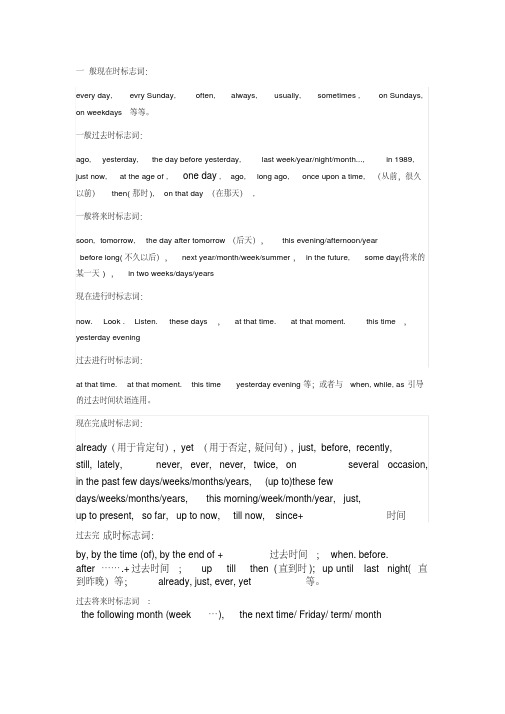
一般现在时标志词:every day, evry Sunday, often, always, usually, sometimes , on Sundays,on weekdays等等。
一般过去时标志词:ago, yesterday, the day before yesterday, last week/year/night/month..., in 1989,just now, at the age of , one day, ago, long ago, once upon a time,(从前,很久以前)then(那时), on that day(在那天),一般将来时标志词:soon, tomorrow, the day after tomorrow(后天),this evening/afternoon/yearbefore long(不久以后),next year/month/week/summer,in the future, some day(将来的某一天) ,in two weeks/days/years现在进行时标志词:now. Look. Listen. these days ,at that time. at that moment. this time ,yesterday evening过去进行时标志词:at that time. at that moment. this time yesterday evening等;或者与when, while, as引导的过去时间状语连用。
现在完成时标志词:already(用于肯定句), yet(用于否定,疑问句), just, before, recently,still, lately, never, ever, never, twice, on several occasion, in the past few days/weeks/months/years, (up to)these fewdays/weeks/months/years, this morning/week/month/year, just,up to present, so far, up to now, till now, since+时间过去完成时标志词:by, by the time (of), by the end of + 过去时间; when. before. after…….+过去时间; up till then (直到时); up until last night(直到昨晚)等; already, just, ever, yet 等。
(完整word版)一般现在时基本用法
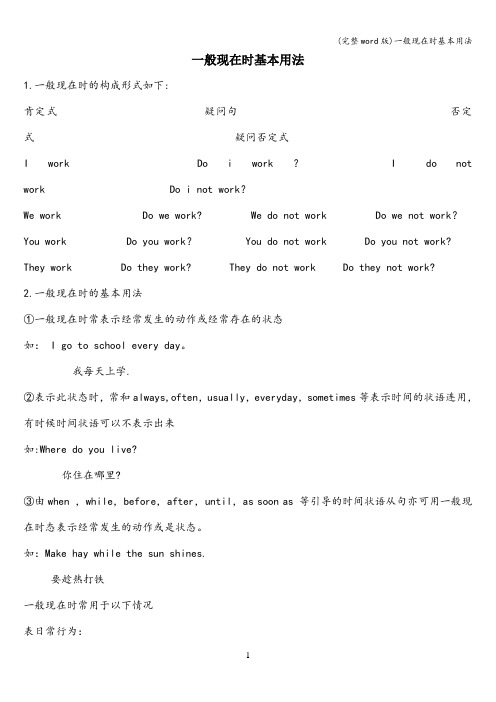
一般现在时基本用法1.一般现在时的构成形式如下:肯定式疑问句否定式疑问否定式I work Do i work ?I do not work Do i not work?We work Do we work? We do not work Do we not work?You work Do you work? You do not work Do you not work? They work Do they work? They do not work Do they not work?2.一般现在时的基本用法①一般现在时常表示经常发生的动作或经常存在的状态如: I go to school every day。
我每天上学.②表示此状态时,常和always,often,usually,everyday,sometimes等表示时间的状语连用,有时候时间状语可以不表示出来如:Where do you live?你住在哪里?③由when ,while,before,after,until,as soon as 等引导的时间状语从句亦可用一般现在时态表示经常发生的动作或是状态。
如:Make hay while the sun shines.要趁热打铁一般现在时常用于以下情况表日常行为:如:The boy wake up at seven a’clock,wash ,dress quickly and run into the dining room for breakfast。
They wait until they hear the bell and then go to school。
这些男孩7点起床,洗漱完毕,很快地穿好衣服,就到食堂去用早餐,然后等上课铃一响就去上课.表习惯,能力等:如:Do you drive, Joho?Joho,你会开车吗?表客观存在:如:Fire burns火会燃烧(表客观事实)The earth moves round the sun。
(完整word版)初中英语六种时态一览表

六种时态一览表时态一般现在时一般过去时现在进行时过去进行时一般将来时现在完成时用法时间标志构成方式表示常性生的表示去某个表示在或段正表示去某正在表示将来某个要作、性作或客生的作或存在的状在行或生的行的作或存在的状生的作或存在的真理、科学事等。
作。
状。
度副: always,the day before now, at the moment, at just then,at this tomorrow ; the dayoften , usually ,yesterday,yesterday,this moment, just moment yesterday, after tomorrow;nextsometimes,seldom,last/yesterday night,now,look, listen, at yesterday morning/day/week/month/year/never;everyday,every last week, last month,present, these days,afternoon/evening, at term; soon; in a fewweek, every month, last year,last term;this week that time,this minutes; by+ 年份 ;every year 等in/on+ 去 ;morning,the whole in+状; in the+ago; just now, at the morning,all day future; in futureage of 5, one day, long yesterday, from+long ago; once upon a数 +to+数+lasttime night, those days 或以when, while 引的是一般去的状等。
(完整版)一般现在时表将来的几种情况(可编辑修改word版)

一般现在时表将来的几种情况:1)下列动词come,go,arrive,leave,start,begin,return 的一般现在时可以表示将来,主要用来表示在时间上已确定或安排好的事情.例如:The train leaves at six tomorrow morning.火车明天上午六点开.When does the bus star?It stars in ten minutes.汽车什么时候开?十分钟后.2)以here,there 等开始的倒装句,表示动作正在进行.例如:Here comes the bus.= The bus is coming.车来了.There goes the bell.= The bell is ringing.铃响了.3)在时间或条件句中.例如:When Bill comes (不是will come),ask him to wait for me.比尔来后,让他等我.I'll write to you as soon as I arrive there.我到了那里,就写信给你.4)在动词hope,take care that,make sure that 等的宾语从句中.例如:I hope they have a nice time next week.我希望他们下星期玩得开心.Make sure that the windows are closed before you leave the room.离开房间前,务必把窗户关了.现在进行时除表进行外,还可以表示将来.现在进行时表将来时常用“意图”“安排”或“打算” 的含义.这种现在进行时比较生动,给人一种期待感.1.它常表最近或较近的将来,所用动词多是转移动词.如:(1)I’m going.我要走了.(2)I'm coming.我要来了.(3)When are you starting?你什么时候动身?2.表将来的现在进行时除用于转移动词外,亦可用于某些非转移动词.如:(1)I’m meeting you after class.课后我找你.(2)What are you doing next Sunday?下星期你打算干什么?(3)She is buying a new bike soon.她不久将买一辆新自行车.3.但偶尔也表示较远的将来.如:When I grow up,I’m joining the army.我长大了要参军.4.表将来的现在进行时有时含有“决心”的意思,多用在否定结构中.如:(1)I’m not going.我不走了.(2)I’m not waiting any longer.我不再等了.5.有时也用在肯定结构中.如:I’m backing out.我要打退堂鼓了.6.用这种现在进行时与对方讲话时可变成命令,不过语气比较温和.如:(1)You are staying.你留下吧.(2)Don’t forget:you are taking part too.不要忘记:你也要参加.7.同一般现在时一样,现在进行时也可在时间、条件或原因状语从句中表示将来.如:(1)when you are passing my way,please drop in.你什么时候路过我们家,请进来坐.(用于时间状语从句)(2)If they are not doing it,what am I to do?如果他们不干,那我该怎么办?(用于条件状语从句)(3)She is going to the dentist tomorrow because she is having a tooth filled.8.表示将来的现在进行时也可用在间接引语中,表示说话人相信它将是事实.如:He said he is going tomorrow.他说他明天走.9.表将来的现在进行时有时从属于将来时态.如:(1)On election night we’ll be telling you what’s happening in various places in this country.到了选举的夜晚,我们将把全国各地的情况告诉大家.(2)when I have time,I’ll come down to the school to see how you’re both doing.我有空时,会来学校看你们俩的学习情况.现在进行时态练习题一、.按要求改写句子1.The boy is playing basketball.否定句:一般疑问句:肯定回答:否定回答:对"is playing basketball"提问:对"The boy"提问:2.They are singing in the classroom.否定句:一般疑问句:肯定回答:否定回答:对"are singing"提问:对"in the classroom"提问:二、. 用现在进行时完成下列句子1. What you (do)?2. I (sing) an English song.3. What he (mend)?4.He (mend) a car.5.you (fly) a kite? Yes, .6.she (sit) in the boat?7.you (ask) questions?8.We (play) games now.9.What are you (do) now? I (eat) bread.10.It's nine o'clock. My father (work) in the office.11.Look, the boy (put) the rubbish into the bin.12.he (clean) the classroom? No, he isn't. He (play).13.Where is Max? He (run) on the grass.14.Listen, who (sing) in the music room?Oh, Mary (sing) there.过去进行时态练习题过去进行时练习:用动词的适当形式填空.1.While we (wait) for the bus,a girl (run) up to us.2.I (telephone) a friend when Bob (come) in.3.Jim (jump) on the bus as it (move) away.4.We (test) the new machine when the electricity (go) off.5.She (not want) to stay in bed while the others(all,work) in the fields.6.While mother (put) Cathy to bed,the door bell (ring).7.I (have) my breakfast at half past six yesterday morning.8.M ary (go) over her lessons from six to seven last night.John and peter(do) the same thing.9.W hat you (do) at that time?We (watch) TV.10.Was your father at home yesterday evening?Yes ,he was.He (listen) to the radio.11.They (not make) a model ship when I saw him.12.they (have) a meeting at 4 yesterday afternoon?No,they .They (clean) the classroom.13.it (rain) when you left school?Yes,it .(No,it )14.What your father (do) when he was your age?15.One day,Edison (wait) for a train to arrive,and suddenly a little boy ran to the track(轨道) to play.16.He asked me if I (go) fishing that afternoon.17.The three of them were in a hurry because their plane (leave) in fiveminutes.18.In a letter,john told us that he (come) to china next month.19.When the bell rang,jenny (wait) in her seat.20.She (make) her dress the whole afternoon.21.While my father (look) through the evening paper,he suddenly a cry.。
(完整版)小学英语时态讲解及练习(可编辑修改word版)

小学英语语法【一】一般现在时一般现在时基本用法介绍一、一般现在时的功能1.表示事物或人物的特征、状态。
如:The sky is blue.天空是蓝色的。
2.表示经常性或习惯性的动作。
如:I get up at six every day.我每天六点起床。
3.表示客观现实。
如:The earth goes around the sun.地球绕着太阳转。
二、一般现在时的构成1.b e 动词:肯定句:主语+be(am,is,are)+其它。
如:I am a boy. 我是一个男孩。
2.行为动词:肯定句:主语+行为动词(+其它)。
如:We study English.我们学习英语。
当主语为第三人称单数(he, she,it)时,要在动词后加"-s"或"-es"。
如:Mary likes Chinese.玛丽喜欢汉语。
动词+s 的变化规则1.一般情况下,直接加-s,如:cook-cooks,2.以s. x. sh. ch. o 结尾,加-es,如:guess-guesses, wash-washes, watch-watches, go-goes3.以“辅音字母+y”结尾,变y 为i, 再加-es,如:study-studies特殊:have --- h as三、一般现在时的变化1.b e 动词的变化。
否定句:主语+ be + not +其它。
如:He is not a worker.他不是工人。
一般疑问句:Be +主语+其它。
如:-Are you a student? -Yes. I am. / No, I'm not.特殊疑问句:疑问词+一般疑问句。
如:Where is my bike?2.行为动词的变化。
否定句:主语+ don't( doesn't ) +动词原形(+其它)。
如:I don't like bread.当主语为第三人称单数时,要用doesn't 构成否定句。
(完整word版)初中英语语法八大时态总结

初中英语语法八大时态1.结构肯定句式: 主语+动词原形/动词的第三人称单数+其他否定句式: 主语+(助动词)don't/doesn't +动词原形+其他一般疑问句式: Do/Does+主语+动词原形+其他简略回答: (肯)Yes,主语+do/does (否)No,主语+do/does not缩写形式: don't = do not doesn't = does not例句:He often goes swimming in summer.I usually leave home for school at 7 every morning.2.用法1)表示经常的、习惯性的动作或存在的状态,常与表示频度的副词连用。
常用的频度副词有:always、often、usually、seldom、never、sometimes, every week (day, year, month…), once a week, on Sundays.频度副词在句中通常放在行为动词之前,系动词、助动词之后。
例如: He often goes swimming in summer.I usually leave home for school at 7 every morning.2)表示主语具备的性格、特征和能力等。
例如:All my family love football .My sister is always ready to help others .Ann writes good English but does not speak well.3)表示客观真理、客观存在、自然现象。
例如:The earth moves around the sun.Shanghai lies in the east of China.4)表示按计划或安排好的,或将要发生的动作,可用一般现在时表将来。
(完整word版)英语各种时态的概念和句型结构1
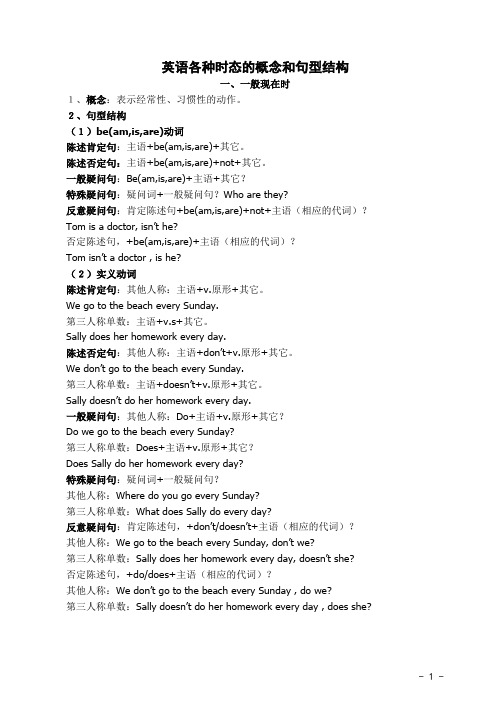
英语各种时态的概念和句型结构一、一般现在时1、概念:表示经常性、习惯性的动作。
2、句型结构(1)be(am,is,are)动词陈述肯定句:主语+be(am,is,are)+其它。
陈述否定句:主语+be(am,is,are)+not+其它。
一般疑问句:Be(am,is,are)+主语+其它?特殊疑问句:疑问词+一般疑问句?Who are they?反意疑问句:肯定陈述句+be(am,is,are)+not+主语(相应的代词)?Tom is a doctor, isn’t he?否定陈述句,+be(am,is,are)+主语(相应的代词)?Tom isn’t a doctor , is he?(2)实义动词陈述肯定句:其他人称:主语+v.原形+其它。
We go to the beach every Sunday.第三人称单数:主语+v.s+其它。
Sally does her homework every day.陈述否定句:其他人称:主语+don’t+v.原形+其它。
We don’t go to the beach every Sunday.第三人称单数:主语+doesn’t+v.原形+其它。
Sally doesn’t do her homework every day.一般疑问句:其他人称:Do+主语+v.原形+其它?Do we go to the beach every Sunday?第三人称单数:Does+主语+v.原形+其它?Does Sally do her homework every day?特殊疑问句:疑问词+一般疑问句?其他人称:Where do you go every Sunday?第三人称单数:What does Sally do every day?反意疑问句:肯定陈述句,+don’t/doesn’t+主语(相应的代词)?其他人称:We go to the beach every Sunday, don’t we?第三人称单数:Sally does her homework every day, doesn’t she?否定陈述句,+do/does+主语(相应的代词)?其他人称:We don’t go to the beach every Sunday , do we?第三人称单数:Sally doesn’t do her homework every day , does she?二、一般过去时1、概念:表示过去某个时间发生的动作或存在的状态。
- 1、下载文档前请自行甄别文档内容的完整性,平台不提供额外的编辑、内容补充、找答案等附加服务。
- 2、"仅部分预览"的文档,不可在线预览部分如存在完整性等问题,可反馈申请退款(可完整预览的文档不适用该条件!)。
- 3、如文档侵犯您的权益,请联系客服反馈,我们会尽快为您处理(人工客服工作时间:9:00-18:30)。
一般现在时态动词三单数的构成:1)一般情况再词尾加-s .例:make-makes play-plays get-gets read-reads2)如果动词原形词尾已有e,只加s. close-closes ride-rides wake-wakes leave –leaves3)以s, x , ch , sh ,o 结尾的动词再词尾加-es. guess-guesses fix, teach, wash, go-goes, do-does4)以辅音字母加y结尾的动词要去y变i 加es. fly-flies , carry , study特殊:have-has用法一般现在时表示现在经常发生的动作或存在的状态。
构成:A. be 动词作谓语注:我用am , 你用are , is 用于他她它。
单数主语用is ,复数主语均用are .缩写词:I am = I’m you are = you’re we are = we’re they are = they’reare not =aren’t he is = he’s she is = she’s it is = it’s is not = isn’t一般现在时表示现在的状态。
The boy is twelve years old /.The workers are very busy .His mother is at work .注:以实义动词作谓语的句子,在一般现在时态中,如果主语是第三人称单数时,谓语动词要变为第三人称单数形式,其余人称均用动词原形。
缩写词:do not = don’t does not = doesn’t1) 表示现在时间经常性反复发生或习惯性的动作,常与表示频度的时间状语连用。
时间状语:every…, in the morning (…) ,at…, on Sunday sometimes,, always , often ,usually , never,etc .I get I[ at 6:30 every day .She always helps others .He often goes to school on foot.I usually leave home for school at 7 every morning.They never play computer games .They often watch TV after supper .I usually go to work on my bike .2) 客观真理,客观存在,科学事实。
The earth moves around the sun. Shanghai lies in the east of China .Summer comes after spring .注意:此用法如果出现在宾语从句中,即使主句是过去时,从句谓语也要用一般现在时。
例:Our teacher said that the earth is round.Our teacher told us that the earth travels around the sun .3) 表示主语现在时刻具备的能力、性格、个性。
She likes noodles .He knows a lot of English .I like playing football .I don't want so much.Wang writes good English but does not speak well.4)在时间、条件状语从句中用一般现在时来表示将来的动作。
He will ring you up when he gets there .I shall leave home if the rain stops .If it doesn’t rain tomorrow , we will go for a picnic .I will give my father a ring as soon as I gets to the school .一般现在时一.意义:一般现在时,通常表示经常发生的动作或存在的状态。
二.一般现在时的构成:1)动词be的第一人称单数为am,第三人称单数为is,第二人称单数及所有复数人称均为are.2) 动词have除第三人称单数用has外,其他人称均用have。
3)行为动词除第三人称单数动词词尾变化与名词单数变复数规则相同外,其余一律同原形。
注:行为动词一般现在时第三人称单数加-s或-es的规则:a. 一般词尾加-s: 如:works likes comes attends seesb. 词尾为ch, sh, s, x, o的动词加-es 如:teaches, washes, fixes, goesc. 辅音字母+y结尾的动词把-y变成I,在加-es: 如:study-studies fly-flies三.一般现在时的用法:1)表示经常发生的动作,现存的习惯或状态。
常与often, always, usually, every day, sometimes, never, once a day, seldom等时间状语连用。
例如:①I am a teacher.②We are Chinese.③She goes to work every day.④He always helps others.2) 表示客观事实或普遍真理。
例如:①There are seven days in a week.②The earth goes round the sun.3) 在连词when, before, if, as soon as, until 等引导的表示将来的行为的状语从句中,常用一般现在时表示将来的动作。
例如;①If it is fine tomorrow, we’ll have a football match.②I’ll ring you up before I leave the office.③When I finish my homework, I’ll tell you a story.4) 表示安排或计划好的未来的动作,只限于go, come, leave, start, stay, return, arrive, begin, be 等动词。
例如:①My train leaves at 6:30 this morning.-②How long do you stay here?③We start at 8 tomorrow morning for Beijing.四.一般现在时的否定式和疑问式1.动词be的否定式和疑问式动词be的否定式由“be的人称变化+not”构成。
疑问式中,be 和主语倒装。
( are not=aren’t is not=isn’t) 如:①Li Ming is not (isn’t) a worker.②They are not (aren’t) college students.③Is Li Wei thirty-two?④Are you from Shanghai?2.动词have 的否定式和疑问式动词have 如果表示“具有”、“所有”,它的否定式和疑问式即可分别用“have或has + not”和“Have you…?”或“Has he/she…?”的形式,又可分别用“do/does not have”和“Do you have…?”“Does he/she have…?”的形式。
当动词have表示其它意义,如have classes have supper/lunch时,它的否定式和疑问式与一般行为动词相同。
(have not=haven’t has not =hasn’t) 如:①I do no t (don’t) have supper at six.②Do the students have English classes every day?3.行为动词一般现在时的否定式和疑问式行为动词一般现在时的否定式由“do not或does not (第三人称单数) + 动词原形”构成。
(do not=don’t does not=doesn’t)疑问式要在主语前加“do 或does”(第三人称单数),后面的行为动词用原形。
如:否定式:I don’t study French.You don’t study French.He/She doesn’t study French.We/ You/ They don’t study French.疑问式: Do you study French?Does he/she study French?Do you study French?Do we / you/ they study French?Ⅰ.请把下列各题的主语改为第三人称单数,并作其他必要的表达变化。
1.I teach English in a junior high school.2.I study English every day.3.I pass by the post office every morning.4.I read and write both English and Chinese every day.5.I have two sisters and one brother.6.I go to school and come home on a bicycle every day.7.I wash my hands before I eat something.8.I don't know her very well.9.I always try my best when I am told to do something.10.On weekdays I always get up at 6:00 . Then I do my bed, brush my teeth, wash my face, and get everything ready in half an hour. At 6:30 I have my breakfast with my parents and sisters and leave for school at 6:50.Ⅱ.请把下列动词选填到各题空格处。
(可以重复选用)(be, begin, belong, cook, cry, do, feel, go, have, help, keep , make, mean, rain, understand )1.My father (1)______ to work by bus every morning .2.(2)______ you (3)______ what (4)______?3.The summer vacation usually (5) ______ on July 1 in most schools.4.We often (6)______ swimming in summer.5.A baby (7)______ when it (8)______ hungry.6.Everyone (9)______ happy and (10) ______ a good time during the Chinese New Year.7.In autumn it (11)______ not (12)______ very often in this part of the country.8.The two little cats (13)______ to my aunt, She (14)______ them as her pets.9.In my family, my mother always (15)______ the meals and my father (16)______ the dishes. But when they (17)______ very busy, I often (18)______ them in the kitchen.10.My bicycle often (19)______ some strange noises,11.I wonder if something (20)______ wrong with it.练习一一、用am, is ,are 填空。
